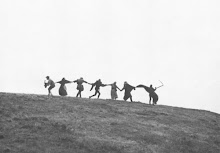 Lady Be Good was an American bomber in the US Air Force during World War II. The plane disappeared on April 4, 1943 after a bombing raid on Naples. Nothing was known of what happened until 15 years later, when a British oil surveyor found the wreckage of the plane deep in the desert — the crew had overshot the base by 400 miles.
Lady Be Good was an American bomber in the US Air Force during World War II. The plane disappeared on April 4, 1943 after a bombing raid on Naples. Nothing was known of what happened until 15 years later, when a British oil surveyor found the wreckage of the plane deep in the desert — the crew had overshot the base by 400 miles.The plane was broken into two pieces, but otherwise in good shape. There was a working radio, food, and water on board. There was even a thermos of tea. What there wasn't, was any sign of a human being. Nor were there any parachutes. It seemed that the men had bailed out, but it was not clear why: the final log entry was written while the plane was still in Naples.
It wasn't until some of the bodies were recovered two years later, at the end of a trail of footwear, parachute scraps, and other discarded articles that the probable story became clear (although much is still mysterious).
The day of the raid presented severe winds all over the Mediterranean. As a result, the bomber was separated from the squadron and the crew uncertain as to their course. They probably flew very close to the base at around midnight: near this time, another base nearby received a voice call from the pilot of Lady Be Good requesting a position report and indicating that their direction finder had malfunctioned.
At about the same time, the staff at Soluch heard the engines, and sent up flares, but the crew missed them. They continued to fly — for two more hours. At that point, running out of fuel, they put on their parachutes and bailed. They were not aware how far inland they had flown: the winds had been heavy all day, there was no moon (April 4, 1943 was a new moon), and with a protocol of radio silence (for fear of drawing the attention of enemy planes). What happened next was recorded in the diaries of two crew members and pieced together from the wreckage and the bodies found.
The first to die was the bombardier: his parachute didn't open properly and he died on hitting the ground (his body was found miles from where they landed). The others, however, didn't know that, and spent some time calling out for him in the darkness. When they couldn't find him, they discarded what they didn't need and set out to the northwest, hoping to come across him on the way. It was 2 a.m. but they had little water and no food; they needed to travel as far as they could before the desert sun rose.
They didn't realize that they were fully 400 miles from the base. Had they known, they could have reached food, water, and a working radio in the wreckage, just a few miles southeast.
They moved northward for 5 days, sharing one canteen of water. At that point five of them gave up: they had walked 78 miles and could see tall dunes ahead. Three had enough strength to continue and, hoping that the base would be just beyond the dunes, promised to send help. It was futile: the base was still hundreds of miles away, and within three days all the crew members were dead.
Sources: ladybegood.com, Wikipedia



No comments:
Post a Comment